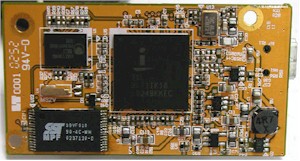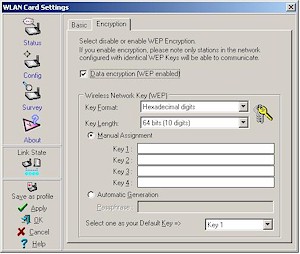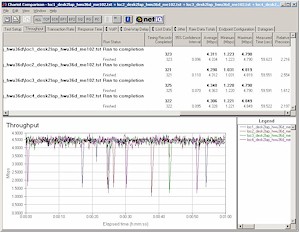Introduction
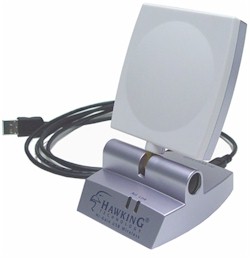
| Hawking Hi-Gain Wireless USB Network Adapter (HWU36D) | |
|---|---|
| Summary | 802.11b USB adapter married to 6 dBi directional antenna in a small package. |
| Update | 10/31/2003 – Updated ODM info. Added info on 11g version |
| Pros | • Compact size • Can help get connected in low-signal locations |
| Cons | • Only connects at 2Mbps with some 11g products • Does not support WPA |
Note: This product has been discontinued and replaced by the HWU54D and HWU8DD.
USB wireless adapters are nifty little items for getting desktops connected to wireless LANs. Some folks like them for laptop use too, since their better antennas and cabled connection provide more options for getting a good connection.
Although most of the innovation in USB adapters lately has been to shrink them to flash-drive size, Hawking has taken the opposite tack. The result won’t exactly fit into your pocket, but it does make a handy solution for difficult-to-reach WLAN locations.
Internal Exam
The Hi-Gain Wireless USB’s (HWU) internal details are shown in Figures 1 and 2.
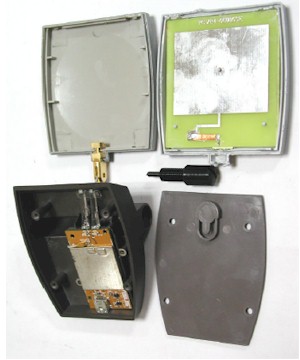
Figure 1: Internal view of the H-WU36D
Figure 2: H-WU36D circuit board
(click on the image for a full-sized view)
Update 10/31/2003 It’s manufactured by Taiwan ODM ASUS, to which Hawking has granted permission to also sell the product as ASUS’ WL140.
The design is based on GlobespanVirata’s (formerly Intersil) PRISM 3 chipset. The USB function is built right into the ISL3871 Baseband/MAC chip, making for a compact design with low part count. Host connection is via a mini-USB connector, but Hawking supplies a 6 foot USB cable that will get you properly hooked up.
Link and Power LEDs are on the front of the adapter’s base and the Link light flashes about once a second when not associated with a WLAN, but doesn’t blink during data transfer.
The antenna coverage pattern is directional and is shown in Figure 3. Maximum gain is spec’d at 6dBi, which as the rule of thumb given in our Wireless LAN Performance Improvement NTK indicates, can possibly double your range.
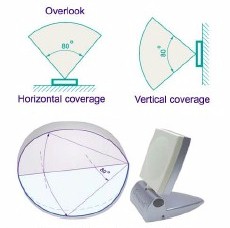
Figure 3: Antenna details
Note that the antenna panel can flip up and over 180 degrees, but can’t be twisted for antenna aiming. This shouldn’t be a problem when the HWU is sitting on a desk, but could limit your options when the adapter is wall mounted, using the slotted screw hole provided on the adapter’s base.
Card Management
If you have WinXP, you’ll be able to manage the HWU without installing its client utility. But you might want to install it anyway and let it manage the card, since it has a number of nice features shown in Figures 4and 5.
Figure 4: Hawking Client Utility – Status
(click on the image for a full-sized view)
Figure 5: Hawking Client Utility – Encryption
(click on the image for a full-sized view)
Unfortunately, support for Wi-Fi Protected Access (WPA) isn’t included in either the driver or utility, so you’ll have to settle for 64 or 128 bit WEP encryption to keep your data secure.
Wireless Performance
NOTES
• Testing was done in a 1GHz Celeron notebook running WinXP home connecting to a NETGEAR ME102 802.11b Access Point
• Details of how we test can be found here.
I began my performance testing using NETGEAR’s new WGT624, which uses Atheros’ 802.11g chipset, as a test AP. The HWU associated without any problems, but try as I might, it would only connect at a 2Mbps rate. This resulted in a maximum throughput around 1Mbps. I next tried a Belkin F5D7130, based on Broadcom‘s 802.11g chipset, but obtained the same result – 2Mbps max connect rate with 1Mbps throughput.
When I reported the problem to Hawking, they said it was the first they’d heard of it and said they’d experienced no problems in tests with their own 802.11g products, which are based on GlobespanVirata’s (Intersil) PRISM chipset. So I dug out a PRISM-based NETGEAR WG602, and confirmed that the HWU did, indeed, connect at 11Mbps and had throughput greater than 4Mbps.
Update 10/31/2003 Although Hawking is looking into possible solutions, they made no committments that the problem will be fixed. But they did say that they’re planning to release an 802.11g version – dubbed the HWU54D – using Envara / Cypress Semi’s USB G chipset at the end of November.
Experiments completed, I turned to my aged NETGEAR ME102 802.11b access point for the remainder of the throughput tests, which are summarized in Figure 6.
Figure 6: H-WU36D via NETGEAR ME102 throughput
(click on the image for a full-sized view)
For each test location, I played with antenna orientation to obtain the best signal. I found that the antenna was, as expected, directional and had best performance when its front was aimed in the general direction of my access point. But I found that, contrary to the information in Figure 3, I also got a useable, although not as good, signal when the back of the antenna was oriented to the access point. Pointing either side of the antenna panel pretty much killed the signal, however.
I found the Overall Connection Quality plot in Hawking’s client utility (Figure 7) to be helpful in orienting the HWU for best signal.
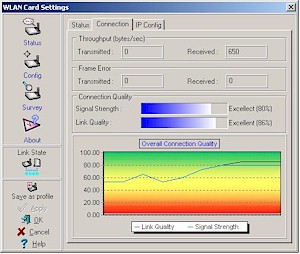
Figure 7: Monitoring the connection
The refresh rate was sufficiently fast and the combination of instantaneous and time-based performance indicators gave me the required feedback for careful antenna aiming. The shot in Figure 7 was taken at my test location 2 and shows the signal strength variation over a 180 degree spin of the HWU. (The antenna was set to a vertical position and I started with the antenna back aimed at my test AP.)
Finally, note that there’s no throughput hit when enabling WEP. But like most other 802.11b products, the HWU doesn’t support Wi-Fi Protected access, either.
802.11b Wireless Performance Test Results” />
802.11b Wireless Performance Test Results
| Test Conditions
– WEP encryption: DISABLED |
Firmware/Driver Versions
AP f/w: |
||||
|---|---|---|---|---|---|
| Test Description | Signal Strength (%) | Transfer Rate (Mbps) | Response Time (msec) | UDP stream | |
| Throughput (kbps) | Lost data (%) | ||||
| Client to AP – Condition 1 | 100 | 4.3 [No WEP] 4.3 [w/ WEP] |
2 (avg) 4 (max) |
409 | 0 |
| Client to AP – Condition 2 | 73 | 4.3 | 3 (avg) 5 (max) |
404 | 0 |
| Client to AP – Condition 3 | 53 | 4.4 | 3 (avg) 4 (max) |
420 | 0 |
| Client to AP – Condition 4 | 73 | 4.3 | 3 (avg) 4 (max) |
420 | 0 |
See details of how we test.
Closing thoughts
I was generally impressed with the H-WU36D. It’s not as cute as the latest mini-USB adapters, nor as inexpensive as older models. But, the combination of current-generation 11b chipset, decent gain antenna, and easy USB connection might be just what you need to extend your wireless LAN to that tough-to-reach location.

